 |
|||||||||




 |
|||||||||




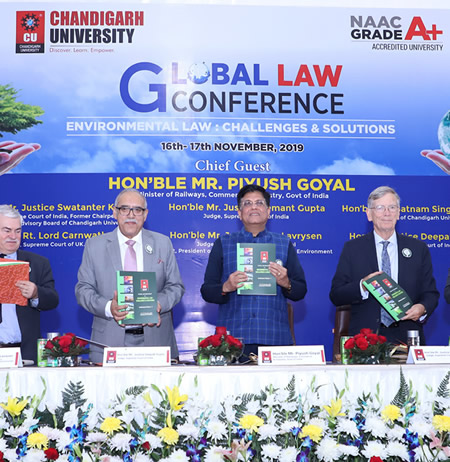
Photo: The Union Minister for Railways and Commerce & Industry, Piyush Goyal, releasing the Conference Volume-I containing research papers on Environment, at the inaugural session of two-day Global Law Conference on ‘Environmental Laws: Challenges and Solutions’, at Chandigarh University, Mohali, Punjab, India, on November 16, 2019.
• The National Assessment and Accreditation Council of India (NAAC) has awarded Chandigarh University with the prestigious ‘A+’ Grade.
|GlobalGiants.Com|
#Ambassadors and #HighCommissioners from 4 Countries Sri Lanka, Malawi, Mexico, and Ghana would be visiting the CU Campus to interact with the students.#CU #ChandigarhUniversity pic.twitter.com/I1vluHWnqS
— ChandigarhUniversity (@Chandigarh_uni) November 18, 2019
Edited & Posted by the Editor | 1:27 PM | View the original post
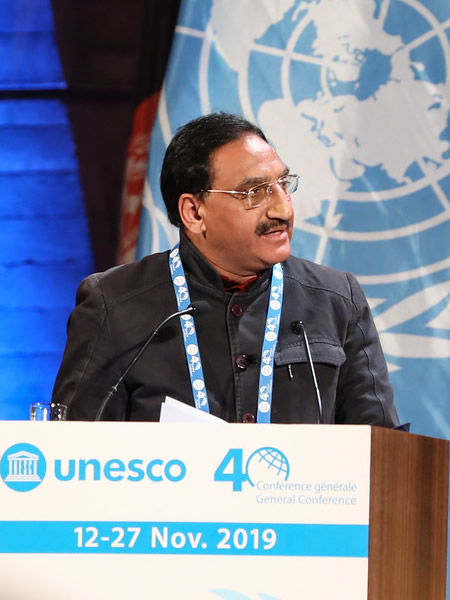
Photo: India’s HRD Minister, Ramesh Pokhriyal ‘Nishank’, addresses education ministers and representatives of nearly 190 countries at the 40th UNESCO General Conference in Paris. November 15, 2019. Image provided by & copyright © UNESCO/Marie Etchegoyen.
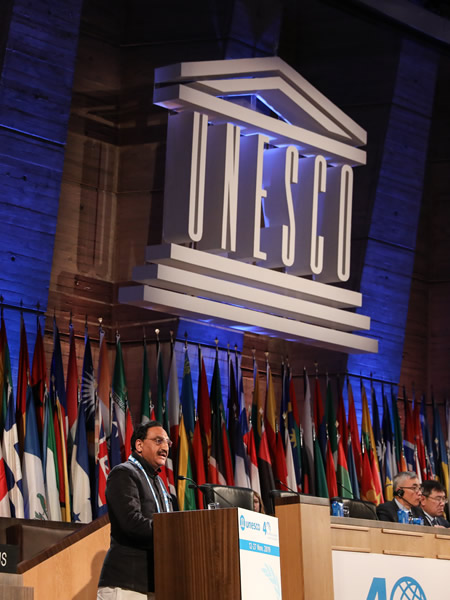
Photo: Dr. Ramesh Pokhriyal ‘Nishank’, Human Resources Development Minister, India, addressed the General Policy Debate at UNESCO General Conference in Paris. November 15, 2019. Image provided by & copyright © UNESCO/Marie Etchegoyen.
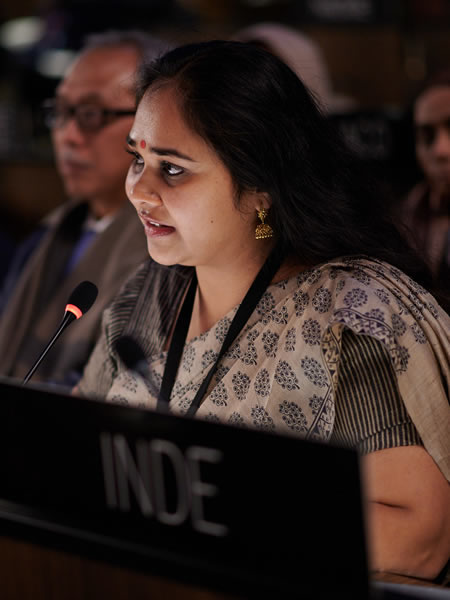
Photo: India’s representative, Ananya Agarwal, spoke forcefully during the General Policy Debate at the UNESCO General Conference in Paris. November 13, 2019. Image provided by & copyright © UNESCO/Luc Valigny.
New Delhi, November 15, 2019 — India’s Union HRD Minister, Ramesh Pokhriyal ”Nishank’, addressed education ministers/representatives of nearly 190 countries at the 40th UNESCO General Conference today in Paris.
He said that age-old immortal Indian culture had considered the whole world as a family. Spreading the great idea of ​​”Vasudhaiva Kutumbakam” all over the world, India has prayed for the welfare of the entire humanity by accepting the hypothesis of “Sarve Bhavantu Sukhinah, Survey Santu Niramaya,” he added. By contemplating the idea of Integral Human Debate, we have pledged to reach out to the last person in the society.
The Minister said that this session of UNESCO has another significance as it is being held at a time when the whole world is celebrating the 150th birth anniversary of Mahatma Gandhi. His message of truth and non-violence is even more critical and relevant today. Through education, we are trying to pursue and spread the spirit of universal brotherhood, social harmony, friendliness, human values, and love to every citizen of India, he added.
Minister ‘Nishank’ said that India is the third-largest education system in the world; therefore, it needs to be committed to building a bright future of more than 33 crore students. There are more than 1000 universities and more than 45000 colleges in India. India has been playing a positive and constructive role to carry forward the UNESCO’s mission and realize our shared objectives.
He assured continuous support of India to UNESCO in its effort to pursue its core mandate of building peace through international cooperation in Education, Science, Environment, and Culture.
He appreciated the efforts of UNESCO to ensure that every child and citizen receive a quality education.
The HRD Minister conveyed his thanks to UNESCO for including the city of Jaipur in the World Heritage List. He also thanked UNESCO for including Kumbh Mela, the world’s largest human gathering, in the list of intangible heritage. Likewise, he also welcomed the selection of Mumbai and Hyderabad for inclusion in the UNESCO Creative Cities Network.
|GlobalGiants.Com|
— The editor is actively, effectively contributing to the enhancement of UNESCO Creative Cities Network (Division of Creativity, Culture Sector, UNESCO) since 2014.
Union HRD Minister, Shri @DrRPNishank addressed #education ministers/representatives of countries at @UNESCO's 40th session of the General Conference in Paris. #unescoGC #UNESCO
— Ministry of HRD (@HRDMinistry) November 15, 2019
Edited & Posted by the Editor | 4:07 AM | View the original post
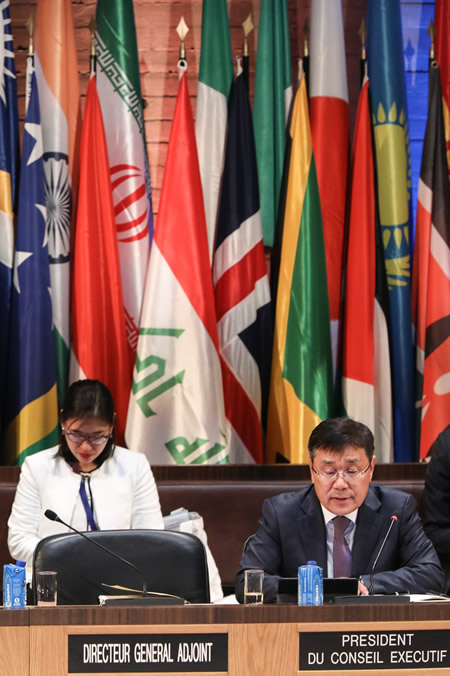
Photo: The Opening of the 40th General Conference of UNESCO. Image provided by & copyright © UNESCO/Marie Etchegoyen.
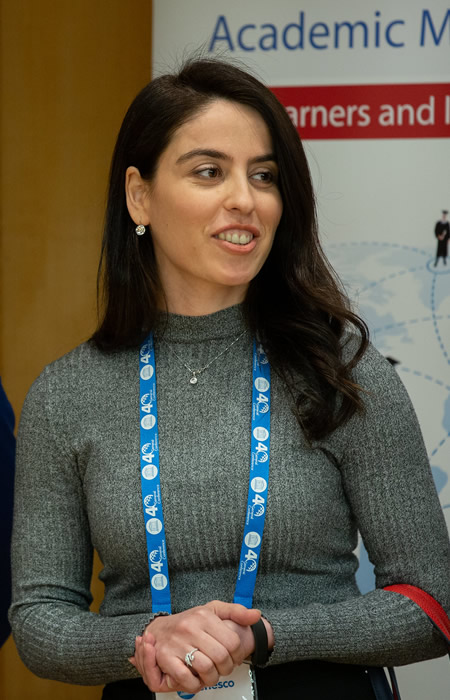
Photo: A Government Representative at the opening of the General Conference. Image provided by & copyright © UNESCO/Christelle ALIX.
Paris, France, November 14, 2019 — Over 100 ministers and 100 representatives from universities, participating in the UNESCO Chairs program convened during UNESCO’s General Conference currently taking place in Paris. They addressed some of today’s most pressing challenges in higher education: How can governments and higher education institutions work together to create a more inclusive global campus in the light of rapidly increasing numbers in enrolment and mobility of students? And how can the higher education sector across the world work against increasing inequalities and for the inclusion of marginalized groups into societies?
The higher education landscape is rapidly changing globally, characterized by increasing internationalization, diversification of providers, and new modes of learning. Two hundred twenty million students are today enrolled in higher education around the world, a number that has doubled over the past decade and is set to expand.
However, increased enrolments have not proven to be a reliable indicator for achieving the 2030 Agenda overall goal of “leaving no one behind,” or for ensuring equitable and affordable quality higher education. Institutions face the challenge of providing quality education to an increasingly diverse student population, including non-traditional learners and disadvantaged groups such as migrants, refugees, and indigenous peoples.
The past decades’ unprecedented increase of enrolment in higher education is also reflected in the mobility of students with the move from an international university to a global campus of learners, faculty, and researchers fast becoming a reality. In the decade leading up to 2011, the number of learners choosing to study outside of their home country more than doubled to 4.3 million students - a figure that is conservatively estimated to increase again by 2025.
Yet many students still face obstacles in having their qualifications recognized when returning to their home country or moving to a new country. Lack of recognition of qualifications constitutes a significant obstacle for accessing further studies or for seeking employment opportunities. Today more than half of students going abroad study outside their home regions.
To respond to this new reality, UNESCO is preparing the adoption of a Global Convention on the Recognition of Qualifications concerning Higher Education at its General Conference that started this week. The new Convention aims to facilitate student mobility and improve access to higher education across regions and continents. UNESCO has also launched a Qualifications Passport to facilitate the movement for refugees with qualifications.
By convening policymakers and universities at this unprecedented meeting, UNESCO aims to strengthen the political will, international cooperation, and capacities in higher education to achieve the 2030 Agenda and to create an understanding of how the Global Convention can facilitate this process.
|GlobalGiants.Com|
Wednesday at #unescoGC: Over 100 ministers of #HigherEducation will gather to make #education more accessible, mobile and meaningful for all
— UNESCO (@UNESCO) November 13, 2019
📚https://t.co/m5vQe95VM6 #IChoosePeace pic.twitter.com/Aj7IWubYGZ
Through art we build peace.
— UNESCO (@UNESCO) November 15, 2019
At #unescoGC, @ArtolutionOrg created a mural for peace & unity together w/ refugees from across the world. @UNESCO Director-General @AAzoulay contributed to the artwork herself, underlining our continuous efforts for a more peacefulðŸŒ. #IChoosePeace pic.twitter.com/drPFkqrizR
Edited & Posted by the Editor | 12:23 AM | View the original post
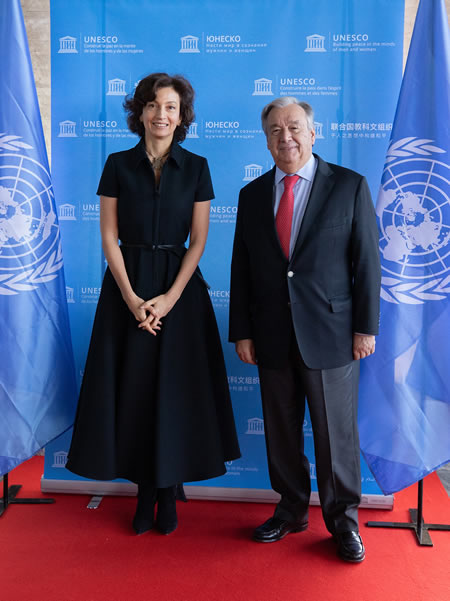
Photo: Secretary-General of the United Nations, Antonio Guterres, and UNESCO Director-General, Audrey Azoulay at the Opening of the 40th General Conference of UNESCO. Image provided by & copyright © UNESCO/Christelle ALIX.
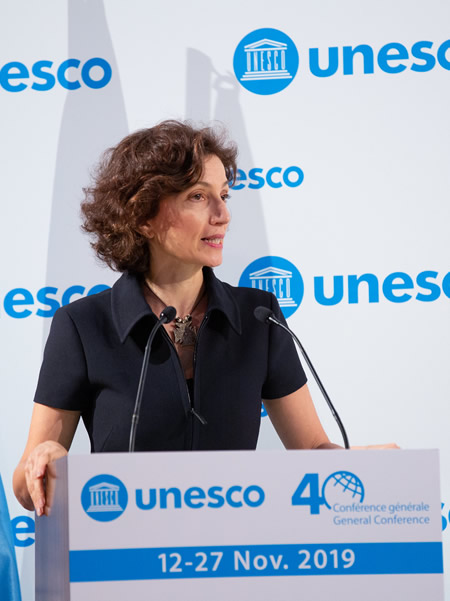
Photo: UNESCO Director-General, Audrey Azoulay addresses the Opening of the 40th General Conference of UNESCO. Image provided by & copyright © UNESCO/Christelle ALIX.
Paris, 12 November—The Secretary-General of the United Nations, Antonio Guterres, Tuesday morning stressed UNESCO’s essential mandate in education and pleaded in favor of multilateralism as he opened UNESCO’s 40th General Conference addressing representatives of the Organization’s 193 Member States and 11 Associate Members.
“Education is an essential pillar to achieve our objectives for 2030. And we are late,” said the Secretary-General. “UNESCO has a fundamental role to play to coordinate and monitor global efforts in this regard. I commend the initiative launched by the Director-General at the UN General Assembly last September on the futures of education.”
Warning against the splintering of the international community along economic, social, and environmental divides, growing hate and discrimination, the Secretary-General declared: “We must do everything to maintain a universal system based on international law and preserve a multipolar world with strong multilateral institutions.”
“A world of cracks and fault-lines is not sustainable,” said the Secretary-General. “In this context, UNESCO’s work is central to bringing the world together.”
After the Secretary-General’s opening, the Member States named Ambassador Ahmet Altay Cengizer, Permanent Delegate of Turkey to UNESCO, as President of the 40th session of the General Conference.
Organization’s Director-General, Audrey Azoulay, denounced the multiple divides that are eroding national and international governance as well as the planet itself. She highlighted UNESCO’s vocation to serve as a laboratory of ideas.
“Contemporary challenges call on us to draw on our shared humanity,” said Ms. Azoulay. “Territorial borders can not contain them. Only cooperation, solidarity, and multilateralism can result in lasting solutions.”
The Director-General denounced the crippling effect of divisiveness on international governance. She said that it is our responsibility “to be effective by making multilateralism an everyday reality and by providing evidence that it can lead to better lives.”
Ms. Azoulay also stressed the importance of education, “the keystone of peace. We must correct not only the insufficiencies and inequalities that education is suffering from but also improve our guidance to the world’s educational systems so that we may lay the best foundations of practical, real, sustainable development.”
The General Conference is the governing body of UNESCO. It meets every other year to determine the Organization’s program and budget.
During its 40th session, which ends on 27 November, Member States are also set to adopt an international convention destined to facilitate the international recognition of higher education diplomas and the free movement of students and faculty.
|GlobalGiants.Com|
Education is everyone’s responsibility!
— UNESCO (@UNESCO) November 13, 2019
It's on all of us to join forces and step up efforts to invest more in quality #education. 📚âœï¸
👉 https://t.co/2N8uexhQRA #SDG4 #GlobalGoals pic.twitter.com/xWwHcgBBLC
Edited & Posted by the Editor | 6:20 AM | View the original post

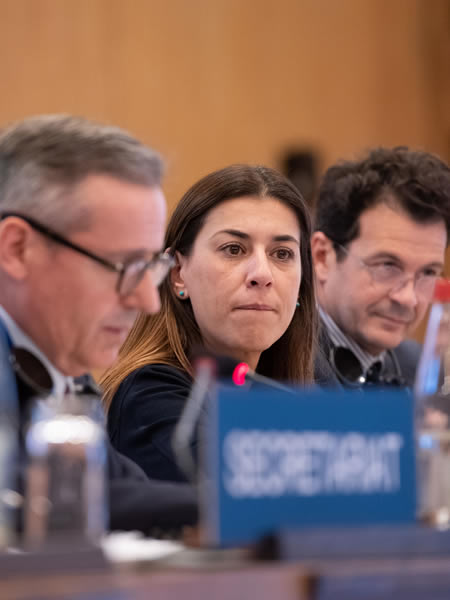
Photo: UNESCO Headquarters, Paris, France. Session of the Executive Board. October 16-17, 2019. Image Credit: UNESCO/C. Bailleul.
Paris, France, November 9, 2019 — In November 2019, UNESCO’s General Conference will examine for adoption the draft text of the Global Convention on the Recognition of Higher Education Qualifications. Once approved, the Global Convention will be the first legally binding United Nations treaty on higher education.
The Global Convention, a binding agreement, will join the ranks of other UNESCO conventions, such as the cultural conventions and the Convention against doping in sport.
The Convention will be the first of its kind in the UN on higher education with a global scope. It will complement the five UNESCO regional conventions on the recognition of higher education qualifications.
Built on the existing regional conventions, the Global Convention will create a framework for fair, transparent, and non-discriminatory recognition of higher education qualifications. The originality of the Convention is that it opens for inter-regional academic mobility, and puts into place universal principles for improving recognition practices.
Under certain conditions, the Convention will be open for countries, which wish to be committed to its text.
Today, more than 4 million students study outside their home country. By 2020 around 8 million students will be studying abroad. The Global Convention on Higher Education Qualifications is designed to facilitate academic mobility between regions. It will mainly benefit people who are seeking recognition of their qualifications in another area than their home region for either accessing higher education or continuing their studies.
For example, it will become easier for a student to have his/her high school diplomas recognized in another region to pursue his/her studies there. It will also facilitate a student who wants to complete a degree in another country based on education that he/she had started elsewhere.
The Global Convention on Higher Education Qualifications will also provide platforms for national authorities to collaborate across borders and regions to develop better tools and practices for the recognition of higher education qualifications.
UNESCO serves as a global platform for discussion on the recognition of higher education qualifications and the promotion of academic mobility. Being the only UN agency with a mandate in higher education, the new Convention is part of UNESCO’s technical support to review more top education strategies and policies in countries that decided to be committed to its text. This support aims to improve equitable access to quality higher education and enhance mobility and accountability.
UNESCO will be the secretariat of the mechanism to be set to ensure and monitor the implementation of the Convention’s text. This implementation mechanism body will meet every two years. It will provide guidance (recommendations, guidelines, and share good practices) to the countries committed to the Convention.
The Global Convention on Higher Education Qualifications will be a reliable instrument to prevent brain drain since it would facilitate governments to put in place mechanisms for recognizing degrees obtained abroad.
The Convention will also help migrants to access higher education in their new home countries as it obliges to put in place mechanisms to facilitate the recognition of refugees’ qualifications, even for those who cannot provide any documentary evidence of their skills.
The idea of a Global Convention on Higher Education Qualifications has been on UNESCO’s agenda for a long time. The formal process started in 2011 after a feasibility study had underlined the urgent need for such a convention to respond to the need for improved recognition of foreign qualifications worldwide. For this purpose, UNESCO established a drafting committee in 2016 consisting of experts from all regions that finalized a preliminary draft in June 2017.
UNESCO presented the draft for discussion at two intergovernmental meetings that took place in December 2018 and March 2019.
At the March meeting, more than 260 technical and legal experts from around 150 Member States approved the plan. Now the draft will be submitted for adoption at the 40th Session of the UNESCO General Conference in November 2019.
|GlobalGiants.Com|
Dear students,
— UNESCO (@UNESCO) November 25, 2019
🚨HISTORY WAS MADE TODAY🚨
The first ever Global Convention on #HigherEducation was adopted at #unescoGC! This will create a system of recognition of higher education qualifications on a global scale, the first of its kind.
📚https://t.co/5rOtm71MR9 pic.twitter.com/s4yizOisEz
Edited & Posted by the Editor | 3:58 AM | View the original post
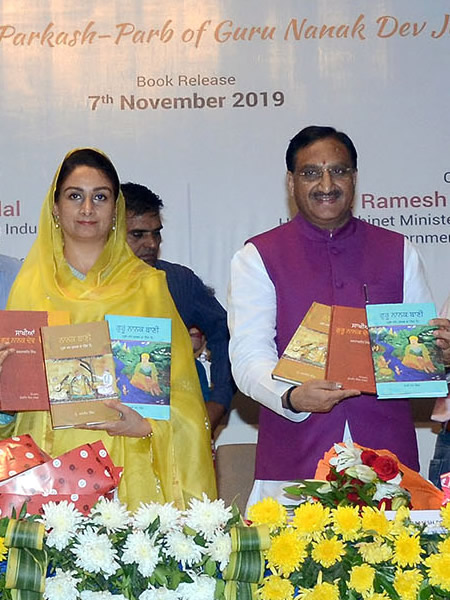
Photo: The Union Minister for Human Resource Development, Dr. Ramesh Pokhriyal ‘Nishank’, and the Union Minister for Food Processing Industries, Smt. Harsimrat Kaur Badal released three Books of the National Book Trust on Guru Nanak at the University of Delhi on November 07, 2019. Dr. Pokhriyal also announced the setting up of Interfaith Center at Guru Nanak Dev University, Amritsar.
New Delhi, November 7, 2019 — Union Human Resource Development Minister, Ramesh Pokhriyal ‘Nishank’, and Union Minister for Food Processing Industries, Smt. Harsimrat Kaur Badal launched three books on Guru Nanak Dev at the University of Delhi today.
The National Book Trust under the Ministry of HRD has published three Punjabi titles - Guru Nanak Bani, Nanak Bani, and Sakhian Guru Nanak Dev to spread the message of Guru Nanak. The National Book Trust has also published the title Guru Nanak Bani in Urdu, Odia, Marathi, Hindi, and Gujarati. It would publish its translations in Assamese, Bangla, Kannada, Sanskrit, Kashmiri, Malayalam, Punjabi, Tamil, Telugu, Sindhi, and English as well.
Mr. Pokhriyal congratulated National Book Trust for bringing out the books on the occasion of the 550th Birth Anniversary of Guru Nanak Dev. The books, he said, are relevant in these times, as the teachings of Guru Nanak Dev are apt in today’s world of complexities, and the youth world over need to follow his outlook of humanity, equality, and ‘One God.’ Mr. Pokhriyal also informed that in addition to the Guru Nanak Dev Chairs in Indian Universities, the Government had announced Guru Nanak Dev Chairs in Universities in the United Kingdom as well as in Canada. He also informed that many programs, seminars, discussions, discourses, and book release functions are being coordinated the world over by Indian missions abroad.
The HRD Minister also announced that an Interfaith Center would be set up at Guru Nanak Dev University, Amritsar, at the cost of Rs 493 crores.
While the National Book Trust, India will publish books on Guru Nanak in different Indian languages, UNESCO will publish Guru Nanak Dev’s writings in major world languages.
|GlobalGiants.Com|
Edited & Posted by the Editor | 12:11 PM | View the original post
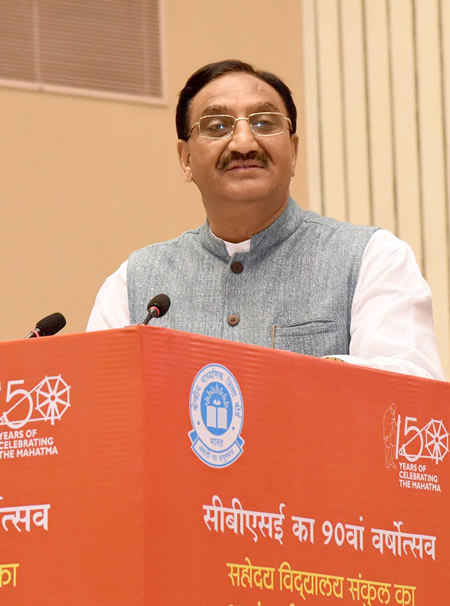
Photo: India’s Minister for Human Resource Development, Dr. Ramesh Pokhriyal ‘Nishank’.
New Delhi, November 4, 2019 — Union Minister for Human Resource Development, Ramesh Pokhriyal ‘Nishank’, graced and addressed the 96th Annual Convocation of Delhi University in New Delhi today. Prof. D. P. Singh, Chairman, University Grants Commission, and Prof. Yogesh Kumar Tyagi, Vice-Chancellor, University of Delhi, were also present.
Dr. Ramesh Pokhriyal ‘Nishank’ lauded the outstanding performance of the students and efforts of all involved in taking this institution to high levels of eminence. Minister encouraged the students to be honest, fearless, and bold towards achieving their goals. He enthused the students with a new level of energy, fresh enthusiasm, and a new direction. Mr. Nishank also congratulated the University for its achievements and wished many more laurels in soon to arrive the 100th year of its establishment in 2022.
Vice-Chancellor of the University of Delhi, Prof. Yogesh Kumar Tyagi, congratulated all the awardees and said that ever since its establishment in 1922, the University of Delhi has been demonstrating consistent progress. It began with about 750 students. Today, it has almost 7 lakh students. The Delhi University alumni family is not only vast but also prodigious and awe-inspiring. Both the Prime Minister of India and the Chief Justice of India are distinguished alumni of our University. In the fitness of things, therefore, Delhi University holds the twenty-first position in World QS Rankings for the criterion of the alumni strength with a score of 96.6 percent. We are proud of our family, and we wish them all the best!
Prof. D. P. Singh, chairman UGC, enlighted the audience about the values of education and its advantages that allow for all-round development of the society.
|GlobalGiants.Com|
आज दिलà¥à¤²à¥€ विशà¥à¤µà¤µà¤¿à¤¦à¥à¤¯à¤¾à¤²à¤¯ के 96वें दीकà¥à¤·à¤¾à¤‚त समारोह में पà¥à¤°à¤¤à¤¿à¤à¤¾à¤— किया। देश के उतà¥à¤•à¥ƒà¤·à¥à¤Ÿ संसà¥à¤¥à¤¾à¤¨ के रूप में दिलà¥à¤²à¥€ विशà¥à¤µà¤µà¤¿à¤¦à¥à¤¯à¤¾à¤²à¤¯ ने न केवल à¤à¤¾à¤°à¤¤ में बलà¥à¤•à¤¿ पूरे विशà¥à¤µ में अपनी विशिषà¥à¤Ÿ पहचान बनाई है । @RajatSharmaLive pic.twitter.com/ecw2s4xo2p
— Dr Ramesh Pokhriyal Nishank (@DrRPNishank) November 4, 2019
Hon'ble Union Minister of HRD, Shri @DrRPNishank attended the 96th convocation of Delhi University today. He congratulated the students and motivated them to achieve greater heights in their career. pic.twitter.com/T7EbmwfMYV
— Ministry of HRD (@HRDMinistry) November 4, 2019
Edited & Posted by the Editor | 12:40 PM | View the original post
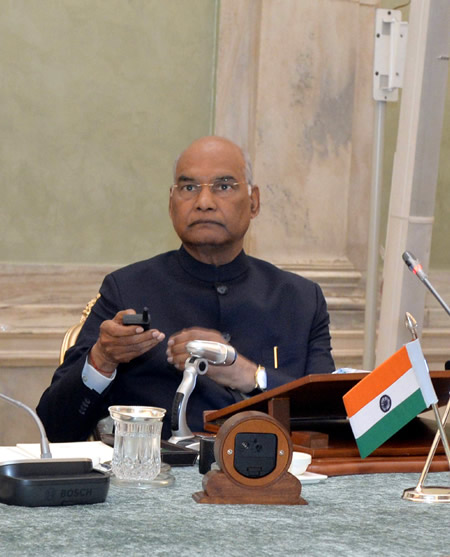
Photo: The President, Ram Nath Kovind, launching the Endowment Fund of Indian Institute Technology Delhi, at Rashtrapati Bhavan, in New Delhi on October 31, 2019.
New Delhi, October 31, 2019 - The President of India, Ram Nath Kovind, launched the Endowment Fund of Indian Institute Technology Delhi at Rashtrapati Bhavan today (October 31, 2019).
The President said that endowments globally have become integral to the financial health of educational institutions over time. While we are still far from the size and importance of endowment funds of Institutions such as Harvard, Yale, or Columbia, it is the right first step in this direction. By giving through endowments, alumni are not just giving to their institution, but they are also supporting and nurturing future generations of learners.
The President said that the best way to honor a gift is to make the best use of it. In the latest QS World University ranking 2020, IIT Delhi was ranked at 182. There is a lot of scope for improvement if it aims to be one of the top institutes in the world. It needs to increase the number of faculty, particularly faculty with international experience. Additionally, it needs to upgrade its infrastructure to ensure its campus, course content, and research facilities are entirely world-class. He expressed the hope that the institute will make use of the valuable contribution from the alumni to bring changes in these areas.
The President said that throughout history, our educational institutes had been the beacons of our culture. We have a tradition of universities enriching lives and showing the way for the people in society.
|GlobalGiants.Com|
Delighted to launch the endowment fund of IIT Delhi.
— President of India (@rashtrapatibhvn) October 31, 2019
Confident that this will act as catalyst for other institutions across the country to launch similar initiatives.
My best wishes to @IITDelhi and its alumni for taking this pioneering initiative in the country. pic.twitter.com/zaIEtRvfvV
Edited & Posted by the Editor | 1:39 PM | View the original post
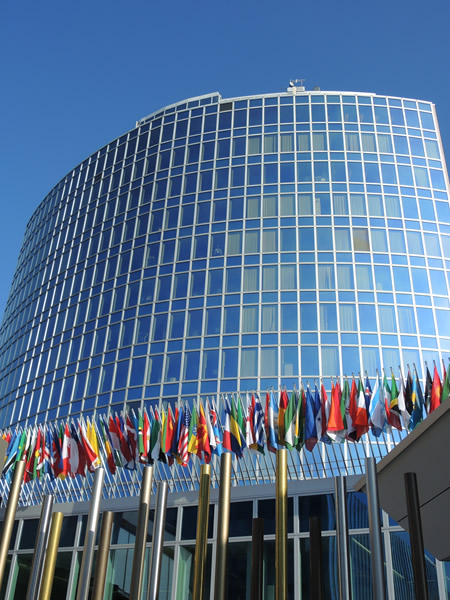
Photo: World Intellectual Property Organization (WIPO) Headquarters, Geneva, Switzerland.
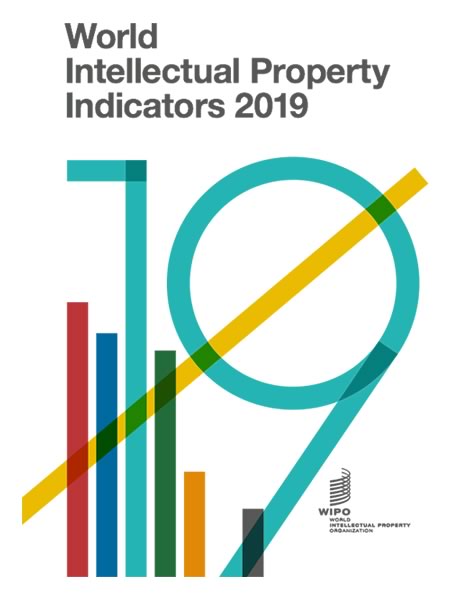
Geneva, October 16, 2019 — Asia accounted for more than two-thirds of all patent, trademark and industrial design applications in 2018, with China driving overall growth in demand for intellectual property (IP) rights. The United States of America (US) maintained its supremacy in patent applications filed in export markets.
Innovators across the globe filed 3.3 million patent applications in 2018, up 5.2% for a ninth straight yearly increase, according to WIPO’s annual World Intellectual Property Indicators (WIPI) report. Global trademark filing activity rose to 14.3 million, while that for industrial designs reached 1.3 million.
“Asia continues to outpace other regions in filing activity for patents, trademarks, industrial designs, and other intellectual property rights. And these intellectual property rights are at the center of the global economy,” said WIPO Director General, Francis Gurry. “China alone accounted for almost half of all the world’s patent filings, with India also registering impressive increases. Asia has become a global hub for innovation.”
Worldwide ‘Plant Variety’ applications grew by 8.9% to reach 20,210 applications in 2018, while data received from 92 national and regional authorities showed some 65,900 protected geographical indications (GIs) in 2018.
• Patents
China’s IP office received the highest number of patent applications in 2018. A record of 1.54 million applications that amounts to 46.4% of the global total. IP offices of the US (597,141), Japan (313,567), the Republic of Korea (209,992), and the European Patent Office (174,397) followed China’s IP office. Together, these five offices accounted for 85.3% of the world’s total.
Among the top five offices, China (+11.6%), the EPO (+4.7%), and the Republic of Korea (+2.5%) recorded growth in applications, while both Japan (-1.5%) and the US (-1.6%) saw small declines. For the US, it was the first decline in applications since 2009.
Germany (67,898), India (50,055), the Russian Federation (37,957), Canada (36,161) and Australia (29,957) also featured among the top 10 offices. All of these offices saw growth in filings, ranging from 7.5% in India to 0.3% in Germany.
• Asia is the hub of global patent filings.
Asia has strengthened its position as the region with the most significant activity in patent filings. Offices located in Asia received two-thirds (66.8%) of all applications filed worldwide in 2018 - a considerable increase from 50.8% in 2008 - primarily driven by growth in China. Offices located in North America accounted for just under one-fifth (19%) of the 2018 world total, while those in Europe accounted for only over one-tenth (10.9%). The combined share of offices located in Africa, Latin America, the Caribbean, and Oceania was 3.3% in 2018.
US applicants filed the most significant number of patent applications beyond its borders.
In terms of filing abroad, which is an indication of a desire to expand in new markets, US residents continue to lead with 230,085 equivalent patent applications filed elsewhere in 2018. Japan (206,739), Germany (106,753), the Republic of Korea (69,459), and China (66,429) followed the US.
• Trademarks
An estimated 10.9 million trademark applications covering 14.3 million classes were filed worldwide in 2018. The number of types specified in forms grew by 15.5% in 2018, marking a ninth consecutive year of growth.
China’s IP office had the highest volume of filing activity with a class count of around 7.4 million; followed by the IP offices of the US (640,181) and Japan (512,156); the European Union Intellectual Property Office (EUIPO; 392,925) and the IP office of the Islamic Republic of Iran (384,338).
Among the top 20 offices, the most substantial increases between 2017 and 2018 were in the IP offices of Indonesia (+29.1%), China (+28.3%), India (+20.9%), the Republic of Korea (+14.5%) and the United Kingdom (+12.4%).
• Asia leads in trademark filings.
Offices located in Asia accounted for 70% of all trademark filing activity in 2018, up from 36.2% in 2008. Europe’s share declined from 38.4% in 2008 to 15.8% in 2018. North America accounted for 5.8% of the world total in 2018, while the combined share of offices located in Africa, Latin America, the Caribbean, and Oceania was 8.4% in 2018.
There were an estimated 49.3 million active trademark registrations worldwide in 2018 - up 13.8% in 2017, with 19.6 million in China alone, followed by 2.4 million in the US, and 1.9 million in India.
• Industrial designs
An estimated 1 million industrial design applications containing 1.3 million designs were filed worldwide in 2018, representing a 5.7% year-on-year increase. China’s IP office received applications containing 708,799 designs in 2018, corresponding to 54% of the world total. EUIPO (108,174), and the IP offices of the Republic of Korea (68,054), the US (47,137), and Germany (44,460) followed China.
Among the top 20 offices, the following five offices reported double-digit growth in design counts: the UK (+42.4%), the Russian Federation (+21%), Italy (+16.6%), India (+13.6%) and China (+12.7%).
• Asia sees the highest design activity.
Offices located in Asia accounted for more than two-thirds (69.7%) of all designs in applications filed worldwide in 2018, followed by Europe (23%) and North America (4.1%). The combined share of Africa, Latin America, the Caribbean, and Oceania was 3.2% in 2018.
Designs related to furnishings accounted for 10.5% of global filing activity, followed by those related to clothing (8.3%) and packages and containers (7.7%).
• Plant varieties
China’s relevant office received 5,760 plant variety applications in 2018, up 29% from 2017. It now accounts for over a quarter of the plant variety applications filed worldwide. The Community Plant Variety Office of the European Union (CPVO; 3,554), and relevant offices of the US (1,609), Ukraine (1,575), and Japan (880) followed China. Among the top five offices, China and Ukraine (+17.1%) saw double-digit growth in filings 2018; CPVO (+3.9%) and the US (+3.3%) reported similar growth rates. Japan (-13.6%) saw a sharp drop in filings.
• Geographical indications
In 2018, there were around 65,900 GIs in force worldwide. GIs are signs used on products that have a specific geographical origin and possess qualities or a reputation that are due to that origin. Germany (15,566) reported the most significant number of GIs in force, followed by China (7,247), Hungary (6,683), and the Czech Republic (6,285).
GIs in force relating to “wines and spirits” accounted for around 51.1% of the 2018 world total, followed by agricultural products and foodstuffs (29.9%) and handicrafts (2.7%).
• Publishing industry
Revenue generated by the trade and the educational sectors of the publishing industry of 14 countries amounted to USD 42.5 billion. The US (USD 23.3 billion) reported the most substantial net revenue, followed by Germany (USD 6.1 billion), the UK (USD 5.4 billion), and France (USD 3 billion).
Online sales channels generated more than half of all trade sector revenue in the UK (51.5%). The US (41.6%), Brazil (25.5%), and Sweden (23.5%) also saw large proportions of their total trade sector revenue generated by online sales channels. However, brick and mortar outlets continue to produce the highest share of total trade sector revenue for all the reported countries, except in Slovenia, the UK, and the US.
The US sold 2.6 billion copies of published titles covering the trade and educational sectors in 2018. The UK (652 million), France (419 million), and Turkey (400 million) followed the US.
The World Intellectual Property Organization (WIPO) is the global forum for intellectual property policy, services, information, and cooperation. A specialized agency of the United Nations, WIPO assists its 192 member states in developing a balanced international IP legal framework to meet society’s evolving needs. It provides business services for obtaining IP rights in multiple countries and resolving disputes. It delivers capacity-building programs to help developing countries benefit from using IP. And it offers free access to unique knowledge banks of IP information.
|GlobalGiants.Com|
— The editor is an alumnus of the WIPO Academy.
Edited & Posted by the Editor | 12:39 PM | View the original post
![]()
Vienna, Austria — International Press Institute (IPI), the global network of editors, media executives and leading journalists, will hold its 2020 World Congress in New York City from September 10 to 12, 2020.
The World Congress is IPI’s flagship event and a top international forum for issues related to media freedom and quality journalism.
“On the occasion of the organization’s 70th anniversary, IPI is honored to be hosted by Columbia University and the Columbia Graduate School of Journalism,” the Institute announced. IPI was founded at Columbia in 1950 by 34 editors from 15 countries to defend journalistic quality and independence.
“The fact that our network stood the test of time is a testament to the importance of our mission,” IPI Executive Board Chair Markus Spillmann said. Spillmann is the former editor-in-chief of Switzerland’s Neue Zürcher Zeitung (NZZ). “Returning to New York just weeks before the United States presidential election puts us at the right place at the right time,” he added.
IPI got established in the aftermath of World War II on the belief that a free press will contribute to a better world. Today, with members in nearly 100 countries, IPI brings together media representatives from digital, print, and broadcast outlets. They address press freedom challenges and promote independent journalism as a core pillar of democracy.
“Media freedom, journalistic independence, and integrity are the guiding principles of our school. They are the values we aim to teach to all our students,” said Steve Coll, Dean and Henry R. Luce Professor of Journalism, Columbia Journalism School.
“We are proud of our numerous alumni who have joined IPI’s fight for media freedom around the world. We look forward to welcoming the IPI community back to Columbia University,” he added.
In the coming days, IPI will announce the leading news organizations and other institutions that will partner with IPI for the 2020 World Congress and 70th-anniversary celebration.
The 2020 Congress will see IPI members and other leading editors, journalists, media executives, and experts from all over the world gather in New York. There would be two-and-a-half days of engaging discussions, roundtables, workshops, and Q&A sessions addressing critical questions for today’s journalism.
“We would like to thank Columbia University for supporting IPI’s efforts and mission since the very beginning,” said IPI Executive Director Barbara Trionfi. “We feel so proud and privileged to have been born at an institution that has played such a key role in defining and spreading fundamental journalistic values worldwide.”
|GlobalGiants.Com|
— The editor is a member of International Press Institute.
Back to our roots!
— IPI (@globalfreemedia) September 24, 2019
IPI is thrilled to announce that our 2020 World Congress will take place at @Columbia University in New York City - where IPI was founded in 1950. #70Years #PressFreedom #IPIWoCo
📌 https://t.co/kWp42Hpnvx pic.twitter.com/DU480s7yw4
Edited & Posted by the Editor | 12:00 PM | View the original post
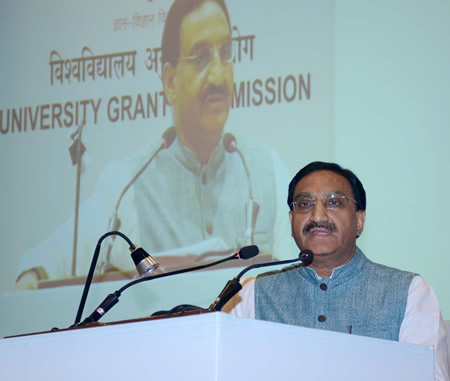
Photo: India’s Minister for Human Resource Development, Dr. Ramesh Pokhriyal’ Nishank’, at the launch of the Annual Refresher Programme In Teaching (ARPIT) and Leadership for Academicians (LEAP), in New Delhi on 16 September 2019.
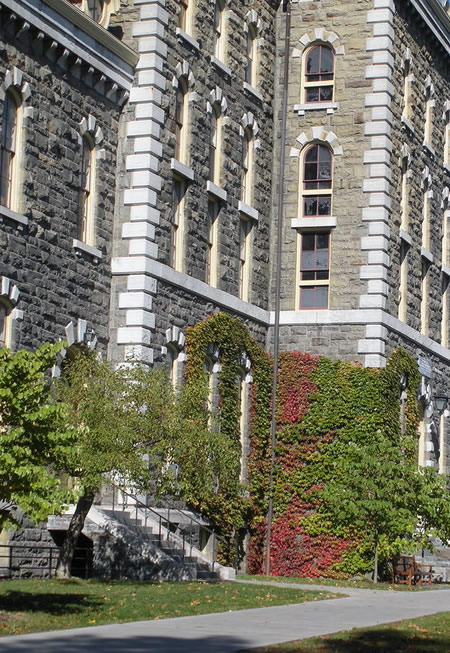
Photo: A building in Cornell Campus. Cornell University (Ithaca, New York) is an Ivy League School. Image Credit: Tom Flemming.
New Delhi, 16 September 2019 — Union Human Resource Development Minister, Ramesh Pokhriyal’ Nishank’, launched Leadership for Academicians Programme (LEAP) - 2019 and Annual Refresher Programme In Teaching (ARPIT) - 2019 under Pandit Madan Mohan Malviya National Mission on Teachers and Teaching (PMMMNMTT) in New Delhi today.
The Minister said that teachers are the base of the education system. ARPIT is an excellent platform for teachers to learn about the latest developments in their field and develop their teaching qualities. He said that for better results, we need to increase the participation of teachers in this program.
He said that we have a vision and mission. We need better coordination, such as between the University Grants Commission (UGC) and All India Council for Technical Education (AICTE).
The Minister appreciated the LEAP program and said that we could develop administrative capabilities and leadership for organizations through this program. He further said that the leaders thus produced would have the responsibility of bringing institutions to the world ranking.
• Leadership for Academicians Programme (LEAP) -
The Leadership for Academicians Programme (LEAP) develops leaders for Higher Education Institutions.
LEAP is a three weeks leadership development program (2 weeks domestic and one-week foreign training) for second level academic functionaries in public-funded higher education institutions. Its main objective is to prepare the second tier academic heads that are potentially likely to assume leadership roles in the future. The Government is implementing LEAP through the following 15 institutions:
The mandatory eligibility conditions are a minimum of eight years of experience as Professor, three years of administrative experience, Impeccable Integrity, and high academic standing.
A maximum of Rs. 10 Lakhs per participant (including foreign training) is approved and each training institution signs MoUs with its international counterpart. LEAP training institution prepares information brochures with relevant information, such as the Structure of the Program, Curriculum, Resource Persons, Pedagogical aspects, Assessment and Evaluation, and Scheduled Dates for Indian & Foreign training. Each training module has a batch of 30 trainees. At the end of the training, the program evaluates the trainees on ten critical leadership attributes, namely, visioning & strategizing; communication skills; people management; conflict management & handling stress; decision making; teaching & learning research and innovation; financial planning and management; administrative skills; understanding students; and collaboration. In 2018-19, out of 15 LEAP approved Institutions, 12 have completed LEAP training with 280 participants.
In 2019-20, a centralized online selection process has been put in place and is now open for applying. The last date of registration is 25 September 2019, and the institution-wise selections would be available by 27 September 2019. The tentative LEAP (2019-20) Training Schedule is as follows:
LEAP Training Institution - Tentative Dates - Proposed Foreign University
• Annual Refresher Programme In Teaching (ARPIT) -
Ministry of Human Resource Development launched the Annual Refresher Programme In Teaching (ARPIT) in November 2018. ARPIT is a unique initiative comprising the online professional development of 1.5 million higher education faculty using the MOOCs platform SWAYAM.
The ARPIT program first identifies the discipline-specific National Resource Centers (NRCs). These NRCs are then tasked to prepare online training material with a focus on the latest developments in the discipline, new & emerging trends, pedagogical improvements, and methodologies for transacting revised curriculum.
|GlobalGiants.Com|
Edited & Posted by the Editor | 2:47 PM | View the original post

Photo: The University of Oxford. Sheldonian Theatre and Bodleian Library from beneath Balliol’s Great Beech. Image Credit: Piers Nye.
London, 11 September 2019 — Times Higher Education today announced its World University Rankings 2020. The rankings include 1,400 universities across 92 countries, standing as the largest and most diverse university rankings ever to date.
The University of Oxford tops the rankings. It is in the first place. The California Institute of Technology is second, while the University of Cambridge is in the third place.
Stanford, Yale, Harvard, UC Berkeley, and Imperial College London all appear in the top fifteen.
Times Higher Education ranks universities on 13 carefully calibrated performance indicators that measure an institution’s performance across teaching, research, knowledge transfer, and international outlook.
Mainland China now provides both of Asia’s top two universities, with Tsinghua and Peking universities finishing at 23rd and 24th place respectively. The country’s universities have continued to expand their influence and presence on the world stage.
Ha Wei, Associate Dean, Graduate School of Education, Peking University, says that China’s excellence initiatives have “poured billions of US dollars” into select groups of universities.” “Talent attraction programs” have also helped the institutions improve, he said.
The latest Double World-Class project, launched in 2015, includes a “monitoring and evaluation system to make it more results-oriented,” Ha Wei added. It means that “those who are deemed less efficient in using the resources will get removed from the list of beneficiaries.”
“I believe the upward trend for Chinese universities will continue,” he said.
• Times Higher Education World University Rankings — Top 30
Source: Times Higher Education
|GlobalGiants.Com|
Edited & Posted by the Editor | 2:28 PM | View the original post


Photo: Russia’s Progress 73 resupply ship approaches the International Space Station’s Pirs docking compartment packed with almost three tons of food, fuel, and supplies for the Expedition 60 crew. Image provided by NASA.

Photo: International Space Station, a variety of solar arrays criss-cross the view. Image provided by NASA.
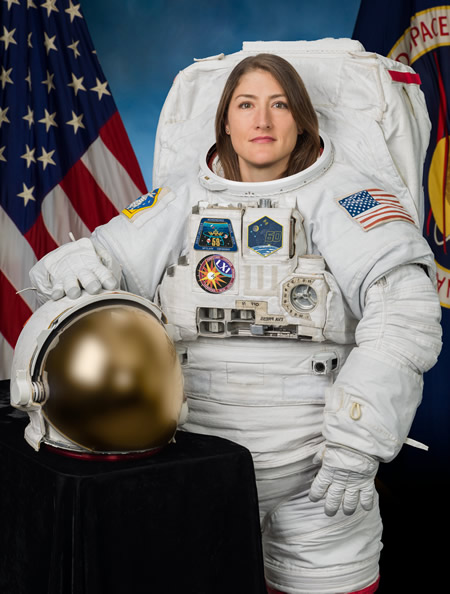
Photo: Official portrait of NASA astronaut Christina Koch. Image provided by NASA.
WASHINGTON, Aug. 14, 2019 — SciGirls viewers from New York will have an opportunity on Monday, Aug. 19, to talk live with NASA astronaut Christina Koch aboard the International Space Station. The Earth-to-space call will air live on NASA Television and the agency’s website.
Koch will answer questions beginning at 10:55 a.m. EDT from girls ages 8 to 14 participating in the “SciGirls in Space” program. SciGirls is a PBS Kids television show, website and educational outreach program engaging more than 14 million girls in STEM learning and careers. The “SciGirls in Space” program includes partners and girls in six states who will participate in the event. The event will take place at the Challenger Learning Center of Ramapo, 225 Route 59, Airmont, New York.
The International Space Station (ISS) is a space station (habitable artificial satellite) in low Earth orbit. The ISS program is a joint project between five participating space agencies: NASA (United States), Roscosmos (Russia), JAXA (Japan), ESA (Europe), and CSA (Canada).
Linking students directly to astronauts aboard the space station provides unique, authentic experiences designed to enhance student learning, performance, and interest in science, technology, engineering, and mathematics.
Astronauts living in space on the orbiting laboratory communicate with NASA’s Mission Control Center in Houston 24 hours a day through the Space Network’s Tracking and Data Relay Satellites (TDRS).
Through NASA’s Artemis program, the agency will send astronauts to the Moon by 2024 and then on to Mars.
Source: NASA
|GlobalGiants.Com|
Edited & Posted by the Editor | 7:44 AM | View the original post
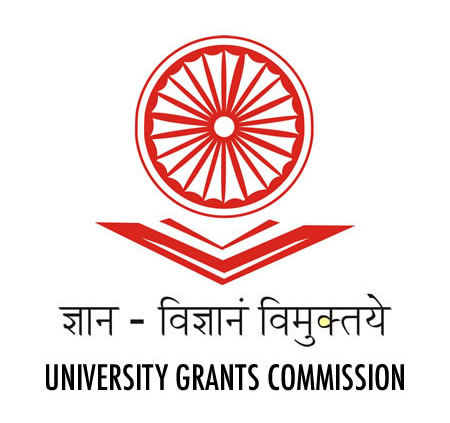
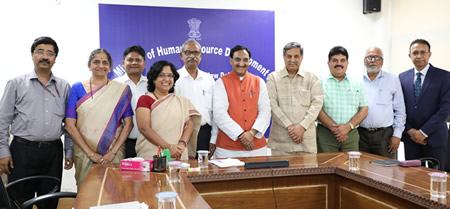
Photo: The Union Minister for Human Resource Development, Dr. Ramesh Pokhriyal ‘Nishank,’ with the University Grants Commission (UGC) Chairman, and the Members. He held a meeting with them. New Delhi. 02 August 2019.
New Delhi, 02 August 2019 — The University Grants Commission (UGC) has recommended the following universities for the coveted “Institution of Eminence” Status:
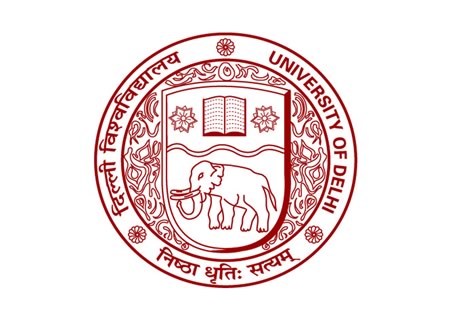
PUBLIC UNIVERSITIES
(UGC will finalize the names of Jadavpur University and Anna University after consultation with the respective state governments.)
PRIVATE UNIVERSITIES
Among the Public Universities, Savitribai Phule Pune University, Pune; Aligarh Muslim University (AMU), Aligarh; Tezpur University, Tezpur, Assam; Panjab University, Chandigarh; and Andhra University, Visakhapatnam were also in the race. They all, however, failed to make the cut as their World Ranking was beyond 800 or they did not figure in the QS World University Rankings 2020.
Following private universities were also in the race: Azim Premji University, Bangalore; Ashoka University, Sonepat; KREA University, Chennai; IIHS (Indian Institute for Human Settlements), and Indian Institute of Public Health, Gandhinagar. These institutions have not been given the IoE status as they did not figure in the NIRF Rankings 2018 and 2019.
In the case of the Private Institutions proposed as Institutions of Eminence, there will be no financial support. They will, however, be entitled to more autonomy as a select category Deemed University.
Each of the ten Public Institutions selected as Institute of Eminence (IoE) will get financial assistance up to Rs. 1000 Crore over five years.
Source: Ministry of Human Resource Development, Government of India.
|GlobalGiants.Com|
Edited & Posted by the Editor | 12:59 PM | View the original post
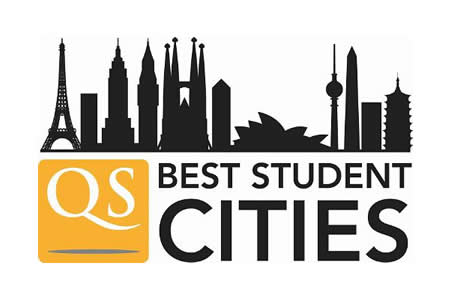

Photo: Bangalore. Bangalore is QS Best Student City in India. Image Credit: M. R. Gears.

Photo: London. Big Ben, and Westminster Abbey. London is the World’s Best Student City. Image Credit: Duane Wessels.
LONDON, July 31, 2019 — London is the world’s best student city for the second consecutive year, according to the latest guide to the globe’s top urban study destinations. The sixth edition of the QS Best Student Cities Ranking, compiled by global consultancy QS Quacquarelli Symonds, sees London outrank competition from Tokyo and Melbourne.
London remains the world’s leading student city due to the high number of top universities present in the city, its high levels of employer activity and student diversity. Further, the global student body holds it in high regard. These positive elements outweigh London’s low ‘Affordability’ score.
QS ranks Student Cities according to:
Feedback from over 87,000 current and prospective international students also impacts the results.
QS Best Student Cities
Rank — City — Country
The Mayor of London, Sadiq Khan, said: “The fact that London has again been ranked the best city in the world in which to be a student is fantastic news. It is no surprise given that London is home to world-leading higher education institutions and a vibrant cultural life. London is open to students and talent from around the world.”
Debuting at 81st position globally, Bangalore has been ranked India’s best city for students. In terms of affordability, Bengaluru is ranked seventh globally.
The other top Indian cities include Mumbai (85), Delhi (113), and Chennai (115). Among these, Mumbai has gained ground, moving 14 places up from last year.
Source: QS Quacquarelli Symonds
|GlobalGiants.Com|
Edited & Posted by the Editor | 3:01 AM | View the original post
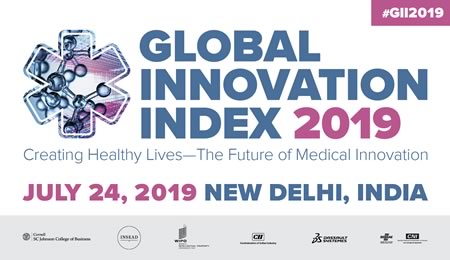
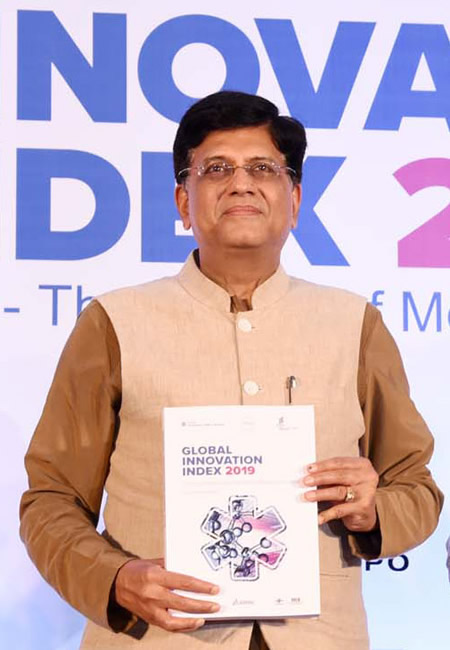
Photo: The Union Minister for Railways and Commerce & Industry, Piyush Goyal, launching the Global Innovation Index - 2019, in New Delhi on 24 July 2019.


New Delhi, 24 July 2019 — Union Minister of Commerce & Industry and Railways, Piyush Goyal, launched the Global Innovation Index (GII) 2019 in New Delhi, today.
India jumped five places to improve its position from 57th last year to 52nd in 2019.
The Minister, Piyush Goyal, congratulated all those involved in the process. He said that India has made significant progress to 52nd rank in the GII-2019 and now the culture of innovation is coming to the center-stage. Mr. Goyal further said that India would not rest on past laurels until it achieves its target of positioning itself among the top 25 countries of the Global Innovation Index. To achieve this ranking, he urged all stakeholders to work in mission mode.
Piyush Goyal urged the R&D institutions, universities, and the private sector to transform the country into a hub of innovation.
The Commerce and Industry Minister in his address said that the improvement in the rankings should inspire Indians to help marginalized and underprivileged section of society. He said India needs innovative solutions to problems like rising pollution levels in cities, water crises, depleting natural resources, climate change, and food wastage.
“The rise in the GII by economic powerhouses like China and India have transformed the geography of innovation,” said WIPO Director General Francis Gurry.
Mr. Gurry thanked the Government of India for hosting the global launch of the GII. “India’s high-level focus on using innovation to foster economic development makes the country an ideal location for the GII 2019 launch,” Mr. Gurry said.
• The GII rankings are published every year by Cornell University, INSEAD and the World Intellectual Property Organization (WIPO).
The GII rankings of 129 economies use 80 indicators ranging from intellectual property filing rates to mobile-application creation, education spending, and scientific and technical publications.
Switzerland remains number one in the GII index. Sweden follows it. The United States of America, the Netherlands, the United Kingdom, Finland, Denmark, Singapore, Germany, and Israel come after that.
Top 20 in Global Ranking
Sources: India Ministry of Commerce & Industry, World Intellectual Property Organization (WIPO), Cornell University.
|GlobalGiants.Com|
Launched today: Global Innovation Index 2019 ðŸŒðŸ’¡ðŸ“ˆ https://t.co/U1WxcDkRCS #GII2019
— World Intellectual Property Organization (WIPO) (@WIPO) July 24, 2019
The world’s innovation leaders:
1. Switzerland 🇨ðŸ‡
2. Sweden 🇸🇪
3. U.S. 🇺🇸
4. Netherlands 🇳🇱
5. U.K. 🇬🇧
6. Finland 🇫🇮
7. Denmark 🇩🇰
8. Singapore 🇸🇬
9. Germany 🇩🇪
10. Israel 🇮🇱 pic.twitter.com/Hk0fjvG9Mg
Modi Govt's thrust on Research and Development making India a Hub of Innovationhttps://t.co/JzZe9bOaO6
— Dr Ramesh Pokhriyal Nishank (@DrRPNishank) July 26, 2019
via NaMo App pic.twitter.com/gScdy0V4sz
Edited & Posted by the Editor | 1:39 PM | View the original post
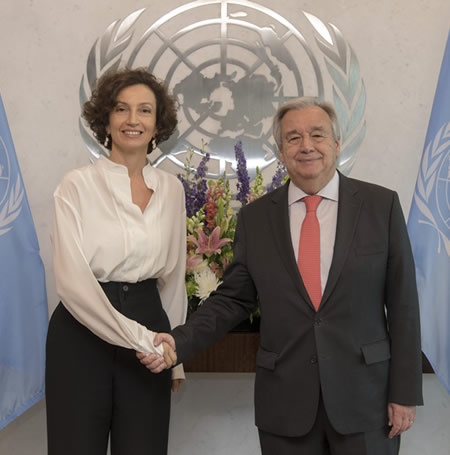
Photo: UN Secretary-General, António Guterres (right), meets with Audrey Azoulay, Director-General of the United Nations Educational, Scientific and Cultural Organization (UNESCO). 16 July 2019. United Nations, New York. UN Photo/Mark Garten.
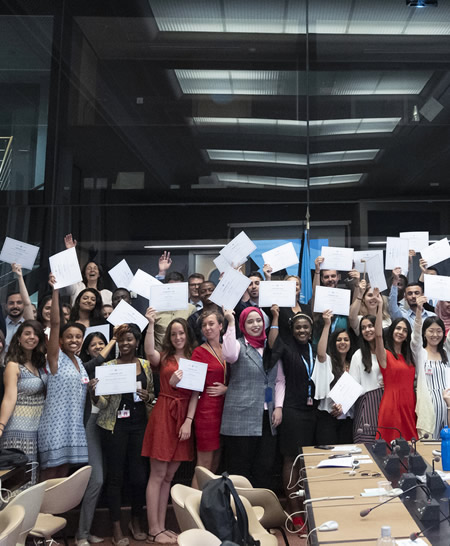
Photo: Group photo of participants of the 57th UN Geneva International Graduate Study Programme during the closing ceremony. The participants are displaying the certificates awarded to them. 12 July 2019. United Nations, Geneva. UN Photo/ Jean-Marc Ferré.
New York, 19 July 2019 — The voices of governments, donors, international organizations, youth, and teachers struck a universal chord in calling for stepped-up action to achieve relevant, equitable and inclusive quality education. They were participating in an event organized by UNESCO, the Group of Friends for Education and the SDG-Education 2030 Steering Committee during the High-Level Political Forum at UN Headquarters in New York.
“Education is a fundamental right and the supporting structure for the entire 2030 Agenda,” said UNESCO Director-General Audrey Azoulay, opening the event. “It is urgent that we act together and step up efforts to invest more in education.” “Governments hold the primary responsibility, but civil society, multilateral and international actors must join their efforts to achieve this common goal,” she said. Ms. Azoulay asserted that UNESCO would continue to make education a top priority to accomplish its global coordination and monitoring role.
Government representatives gave examples of how Sustainable Development Goal 4 on education is influencing national policy, demonstrating its relevance to all contexts. The Minister of Research and Higher Education of Norway, Ms. Iselin Nybo, proposed actions to integrate sustainable development across all school subjects and university programs. To achieve the SDGs and build better societies, she called for the “democratization of knowledge” to ensure that the fruits of research are widely shared.
Argentina has placed a priority on ‘leaving no one behind” through affirmative actions at all levels, explained Oscar Ghillione, the country’s deputy Minister of Education. Having hosted the first G20 conference of education ministers in 2018, Argentina is also striving to “place education at the heart of the global debate,” he said.
Jaime Saavedra, head of Education Global Practice at the World Bank, called for a “completely different level of political commitment.” He warned that “many kids are in learning poverty” as proven by assessments showing that over half cannot understand a simple story. “This is morally unacceptable,” he said.
UNESCO Assistant Director-General for Education, Stefania Giannini, wrapped up the event by stressing urgency, accountability, solidarity, and political engagement to accelerate global action for education.
|GlobalGiants.Com|
Edited & Posted by the Editor | 1:12 PM | View the original post
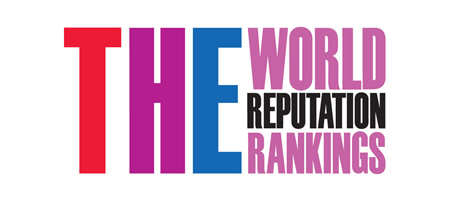
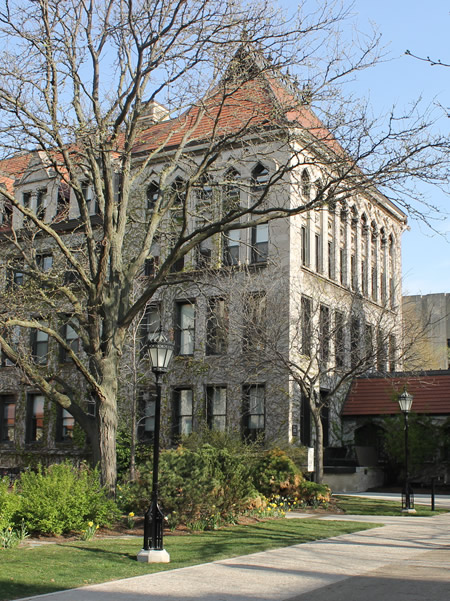
Photo: A building at the University of Chicago. Image Credit: Corey Seeman.
London, 17 July 2019 — The most valuable asset in a crowded market is reputation. Times Higher Education (THE) today announced the World University Reputation Rankings 2019 comprising the world’s top 100 most prestigious universities.
According to Times Higher Education, its World University Reputation Rankings are created using the world’s largest invitation-only academic opinion survey.
The Times Higher Education (THE) World University Reputation Rankings 2019 are based on the world’s largest invitation-only opinion survey of senior published academics. It asks scholars to name no more than 15 universities that they believe are the best for research and teaching in their field, based on their own experience.
The US continues to dominate the table in 2019, with 42 representatives in the overall top 100, led by Harvard University in first place for the ninth consecutive year.
The UK has ten institutions in the rankings, up from nine last year, headed by the University of Cambridge in fourth place.
Australia has doubled its representation this year, claiming six spots, up from three. Its most prestigious institution, the University of Melbourne, is now ranked joint 44th, up from joint 47th.
Meanwhile, Japan’s University of Tokyo sits just outside the top 10 in 11th place, up from 13th last year. It is the top-ranked university outside the US and UK.
Elsewhere, a Canadian university features in the top 20 for the first time since 2015; the University of Toronto is ranked 19th, up from joint 22nd last year.
Brazil’s University of Sao Paulo is back in the ranking in the 81-90 band; it was absent last year.
Overall, 19 countries are represented across the top 100 list of the most influential global university brands, down from 21 last year.
This year, no institution from India figures in the Times Higher Education World University Reputation Rankings. Last year, the Indian Institute of Science (IISc) Bangalore has made it to the list in the 91-100 band.
According to Times Higher Education, the 2019 rankings are based on a survey of 11,554 respondents in 135 countries, across all core academic disciplines, carried out in the spring of 2019.
• World’s Top 100 Most Prestigious Universities in 2019
RANK — INSTITUTION — COUNTRY
51-60
61-70
71-80
81-90
91-100
The Times Higher Education World University Reputation Rankings list the world’s top 100 universities purely on their Academic Prestige as distinct from their Academic Performance.
According to Times Higher Education rankings editor Phil Baty, “A university’s reputation for academic excellence is vital for its success.”
A university’s brand - crucial in helping to attract students, staff, and funding - is built on esteem.
Source: Times Higher Education
|GlobalGiants.Com|
Edited & Posted by the Editor | 10:25 AM | View the original post

Photo: College students, downtown, Sao Paulo, Brazil. Image Credit: Fernando Stankuns.

Photo: College students, downtown, Sao Paulo, Brazil. Image Credit: Fernando Stankuns.

Photo: Auto show, Santiago, Chile. Image Credit: Francisco Osorio.
LONDON, July 13, 2019 — The UK and US are home to the most cultural cities for students. A new study by Oxford Summer Courses examined the towns that are home to some of the world’s most prestigious colleges and ranked them according to the number of museums, cinemas, libraries, theaters and street markets per 100,000 people. The UK and US lead the list, with the American city of Berkeley in California coming out on top.
Second in the ranking was Ithaca, home to the Ivy League Cornell University. Ithaca, New York, is ranked high for its museums and theaters. Cambridge (UK) follows Ithaca. Cambridge (UK) is ranked highly across all categories, in particular, public libraries and theaters. The UK overall is well represented, with six cities - Cambridge, Edinburgh, Oxford, Glasgow, Bristol, and Manchester - featuring in the top 20.
The United States and the United Kingdom both ranked highly in the top 20, with eight and six cities featured, respectively.
Cambridge (3rd place) beat out old-time rival Oxford (8th place) in the ranking.
Continental European cities outside the UK also performed well, with Amsterdam, Paris, Lausanne, and Zurich making to the top 20.
The top 10 cities, according to the research, are:
Paris’s inclusion on the list - in 7th place - is no surprise. It has some 300 museums and 132 theaters. Amsterdam and Edinburgh have been rated two spots above Paris for their collections of museums and bold cultural identities.
The results show that the UK has much to offer students from a cultural perspective. Historic cities such as Oxford and Cambridge not only rank highly in traditional cultural categories, such as theaters, museums, and libraries but also live music venues and street food markets.
Interestingly, despite their reputations as cultural beacons of the world, metropolises London and New York come in at relatively low 25th and 42nd positions, respectively. Although neither are short of cultural places to visit, their large populations mean that each scored relatively small on a per capita basis.
The cities selected for rating are home to Top Global Universities and lead in providing the following cultural facilities:
The study concludes that the culture offered by a city forms an integral part of the student experience.
|GlobalGiants.Com|
Edited & Posted by the Editor | 3:04 PM | View the original post
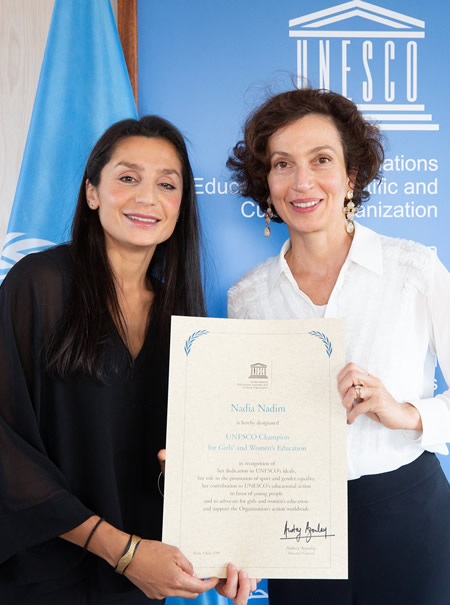
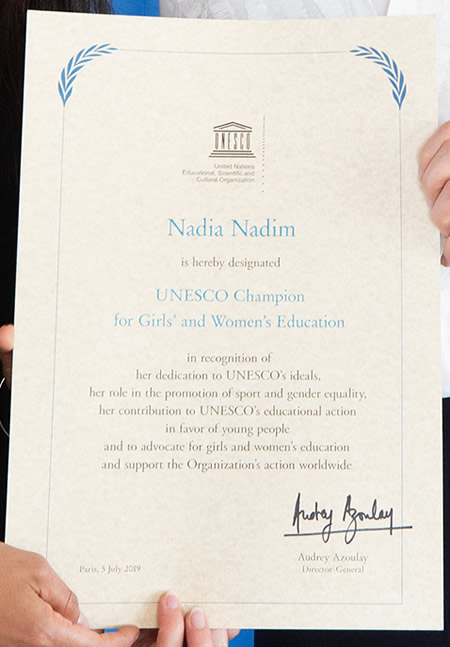
Photos: Nomination of Nadia Nadim as UNESCO Champion for Girls’ and Women’s Education. Images provided by & copyright © UNESCO / Christelle ALIX.
Paris, France, 12 July 2019 — UNESCO Director-General Audrey Azoulay on 5 July named Nadia Nadim, the Afghan-born Danish football striker for the French women’s Paris Saint-Germain team, UNESCO Champion for Girls’ and Women’s Education.
Ms. Azoulay designated Ms. Nadim in recognition of her role in promoting sport and gender equality, her contribution to UNESCO’s educational action in favor of young people, advocacy for girls and women’s education and support for the Organization’s work worldwide.
The designation took place as UNESCO launched a significant initiative, “Her Education, our Future” to mobilize political and financial support for girls and women’s education. UNESCO is working to improve the quality of data that education policymakers require to accelerate gender parity.
Ms. Nadim was born in Herat, Afghanistan. Following the execution of her father, an Afghan National Army (ANA) general in 2000, the family sought refuge in Denmark where Ms. Nadim began her career in football. In 2018, she published a book, My Story.
While pursuing her career in football, Ms. Nadim is a student of medicine at the University of Aarhus (Denmark).
The star football player shares UNESCO’s conviction that education can improve girls and women’s future. Ms. Nadim subscribes to UNESCO’s belief that knowledge can enhance their economic independence, self-confidence, and ability to assert their rights. Ms. Nadim’s award comes in recognition of her inspiring ability to serve as a role model, and her determination to put her heart and reputation at the service of girls and women everywhere.
As a UNESCO Champion for Girls’ and Women’s Education, Ms. Nadim joins UNESCO’s family of distinguished champions, committed to the Organization’s ideals and objectives, like the football players Edson Arantes Do Nascimento (Pelé) and Rabah Madjer.
|GlobalGiants.Com|
Edited & Posted by the Editor | 3:51 PM | View the original post
 |
 |
